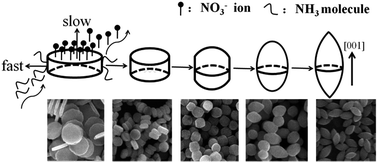Effect of sequential morphology adjustment of hematite nanoplates to nanospindles on their properties and applications
Abstract
We investigated the marked morphological changes of α-Fe2O3 nanocrystals from nanoplates to nanospindles via an environmentally friendly hydrothermal route. An aqueous Fe salt was used as the precursor and the volume ratio of ammonia to ethylene glycol was varied. The product was uniform and obtained at a high yield. By simply increasing the ratio of the aqueous phase, the morphology could be continuously tuned from nanoplates to nanospindles with the (001) facets gradually disappearing. A fundamental understanding of the shape evolution was obtained via a series of characterizations including X-ray powder diffraction, scanning electron microscopy and transmission electron microscopy. The NO3− ions and NH3 molecules played vital parts at increased temperatures, not only in the phase structure of the iron oxide, but also in the formation of different hematite morphologies with different properties. The decrease in the photocatalytic efficiency in the visible region with the change from nanoplates to nanospindles under the same conditions indicated that the increase in the number of exposed (001) facets promoted the photocatalytic performance. The magnetic and electrochemical properties of typical morphologies were investigated and showed the potential applications of the nanostructures in various fields.


 Please wait while we load your content...
Please wait while we load your content...